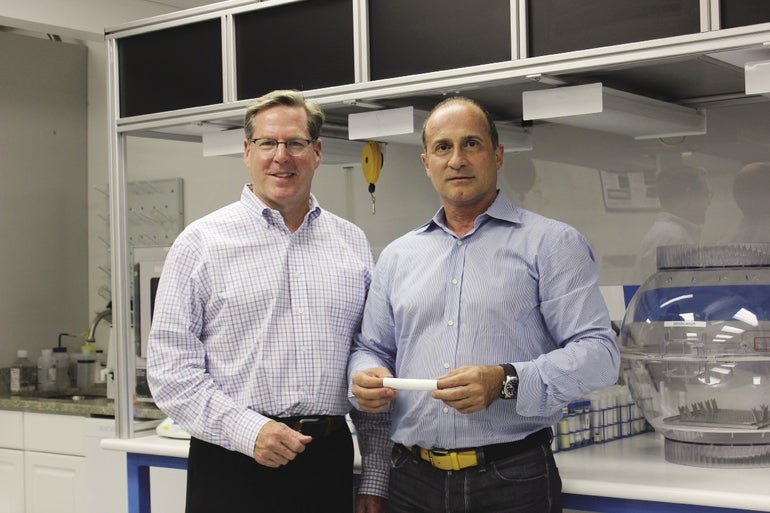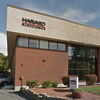Holliston biotech seeks to fulfill $1.5-billion potential
 PHOTO/LAURA FINALDI
Biostage CEO Jim McGorry (left) and Chief Medical Officer Saverio La Francesca hold one of the company's synthetic scaffolds that have worked to regrow esophaguses in pigs.
PHOTO/LAURA FINALDI
Biostage CEO Jim McGorry (left) and Chief Medical Officer Saverio La Francesca hold one of the company's synthetic scaffolds that have worked to regrow esophaguses in pigs.
Over the past year, Holliston-based Biostage has revamped its upper management, changed its name and used its technology to partially recreate the esophaguses of several Yucatan pigs.
The company, which until March was known as Harvard Apparatus Regenerative Technology, is the maker of Cellframe organ implants, bioengineered organ regeneration technology that has proven it can successfully recreate parts of a pig's esophagus.
Now the next question is, will it work on humans? Biostage thinks it can.
The small biotech company, with 22 employees, is in the process of putting together its investigational new drug (IND) filing with the U.S. Food and Drug Administration for Cellspan esophageal implants. If approved, human testing could begin in 2017, said president and CEO Jim McGorry.
The three-year-old company hopes the implant will meet the FDA's orphan drug criteria, which would get the $672,000 IND application fee waived. The goal is commercialization by 2020.
“We're right at that moment, if you will, of moving to preclinical to clinical right now. And that's an exciting moment,” McGorry said.
Regenerative approach
The esophageal implant is one of four being developed by Biostage, including Cellspan bronchial, tracheal and pediatric esophageal implants. The current priority, however, is the Cellspan esophageal implant, which the company hopes will be transformative for patients with esophageal cancer.
Today, patients diagnosed with esophageal cancer can undergo a procedure called an esophagectomy. After part of the esophagus is removed due to tumor or trauma, either the stomach or a part of the colon can be pulled up into the chest, as a replacement for the esophagus. It's a high-risk procedure that can lead to life-threatening complications and costly medical care.
The Cellspan esophageal implant, Biostage hopes, is a solution to this problem. Stem cells are gathered from a patient's abdomen via a biopsy, isolated, expanded, and then seeded onto one of Biostage's biocompatible synthetic scaffolds. After three to five days in a rotating bioreactor, the device is surgically implanted in place of a removed section of the esophagus. After three weeks, the scaffold is removed, and after a few months, the esophageal tissue has completely regenerated itself, creating a new, healthy organ.
Two weeks into the animal study, there was already enough regenerated tissue for the animal to eat and thrive without complication, said Saverio La Francesca, Biostage's chief medical officer, who has been responsible for spearheading the development of the Cellframe technology. Complete organ regeneration takes a few months, and some animals are still ongoing, he said.
It's a combination product – part medical device, part cells – and is designated that way by the FDA, McGorry said. It could reduce surgical complications and expand treatment options to patients deemed unfit for surgery, and lower long-term costs, according to the company.
“Our sweet spot is cells on a scaffold,” McGorry said.
That combination has produced some interesting results at Connecticut Children's Medical Center, where Biostage bioreactors and scaffolds are used to build an implant for esophageal regeneration in mini swine. In the second to last week of July, the first set of pigs were just over 40 days into their trial, and so far, the results were impressive, said Dr. Christine Finck, CCMC surgeon-in-chief and chief of the division of pediatric surgery.
The pigs' esophaguses are regenerating, with a little bit of scar tissue. The idea is that if the cell-seeded scaffold can regenerate a pig's entire esophagus, it might also work in children born with esophageal atresia, meaning the two ends of their esophagus are not connected, Finck said.
She estimates her team will treat four more sets of pigs by this time next year.
“I'm hoping that we land upon a clinically relevant, off the shelf, patient-specific scaffold to help with tissue regeneration of the esophagus,” she said.
From H.A.R.T. into Biostage
In the fall of 2013, Harvard Bioscience, Inc. spun off its regenerative medicine business into what was then known as Harvard Apparatus Regenerative Technology, Inc., now Biostage. Harvard Biosciences contributed $15 million in cash and its regenerative medicine business, and completed the spin-off through distribution of all common stock shares of Biostage to Harvard Biosciences stockholders, according to U.S. Securities and Exchange Commission filings.
It was then Harvard Biosciences and Biostage entered into a 10-year product distribution agreement, ensuring each company will exclusively distribute the other party's products, developed by such other party for sale in markets served by the other. Bioreactor sales to Harvard Bioscience account for 100 percent of Biostage's current revenue and receivables, SEC filings show.
“The company has evolved, if you will, from a bioreactor to a biotechnology company,” McGorry said.
Biostage will incur operating losses and negative operating cash flow for the foreseeable future, according to SEC filings, because the company is investing its resources in development and commercialization of its regenerative products. The company's first quarter, ending March 31, showed an operating loss of nearly $2.5 million, a figure equal to its operating expenses. However, the company estimates that total revenue opportunity for all three Cellspan implants, once commercialized, could exceed $1.5 billion.
In May, Biostage announced, in a joint project with the Mayo Clinic, it had successfully used its Cellspan esophageal implants to regenerate a section of esophagus in Yucatan pigs – bigger than mini swine and more comparable to adults. The pigs appeared healthy, with no evidence of leakage or infection at surgery sites.
The company had hoped the announcement would build some momentum on the stock market. However, despite the encouraging results, Biostage's stock traded down 15 percent after the announcement, due to what McGorry said were funding concerns surrounding the company's $4.8-million cash position as of March 31. After evaluating several financial avenues, the company decided to negotiate a $5-million at-the-market offering in an effort to secure its cash position so it could execute short-term plans.
These are some of the challenges small, research-driven companies face as they seek regulatory approval for their products, McGorry said.
“I'm a 31-year healthcare guy, but first-time CEO. Do I think there's a big difference between value of the company and the value of stock price? Absolutely,” McGorry said. “We're just trying to get some continued visibility around some of the patient advocacy groups, the Mayo Clinic and Connecticut Children's.”
Management revolution
McGorry started as CEO in summer 2015. He came in from big biotech companies like Genzyme and Baxter Healthcare, but was drawn to the small, research-driven company, because he has experience bringing things to the market and finds that exciting.
“This is true innovation. So many things are 'Me, too' – they're just trying to make a better mousetrap. This is total unmet medical need,” he said. “This is what breakthroughs are all about, and that's what I'm attracted to, to really make a difference.”
Most of the management team is brand new, as the company solidifies the expertise and experience it needs to advance Cellframe to commercialization. Vice President of Regulatory Affairs Laura Mondano, a former Genzyme colleague of McGorry's, joined in March, and Ginger Abraham-Freel joined as director of quality and operations in April from Diagnostics for All, Inc., where she was director of quality and head of manufacturing.
Harout DerSimonian, a healthcare veteran with more than 20 years of experience in immunotherapy and cell therapy program development, joined as chief science officer in June.
With them, La Francesca, and Chief Financial Officer Tom McNaughton, McGorry said the right team is in place.
“We're helping the body heal itself,” McGorry said. “The body knows how to heal itself when given the right clues.”









0 Comments